Blog
Last week, the Grade 4 class learnt about Diwali and its significance to Hindus around the world.
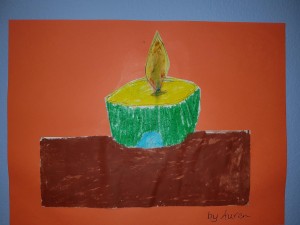 Diwali (in Hindi) is the Hindu Festival of Lights. The name originally comes from the Sanskrit word dipavali, meaning a row of lights. Wherever Diwali is being celebrated you will see shops, houses and public places decorated with small, earthenware, oil lamps known as diyas. They are usually placed in rows on window sills and outside buildings as decorations.
Diwali (in Hindi) is the Hindu Festival of Lights. The name originally comes from the Sanskrit word dipavali, meaning a row of lights. Wherever Diwali is being celebrated you will see shops, houses and public places decorated with small, earthenware, oil lamps known as diyas. They are usually placed in rows on window sills and outside buildings as decorations.
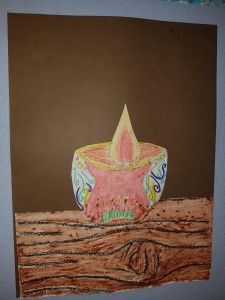 Diwali is celebrated around the world by people who follow the Hindu religion. This is mostly those of Indian ethnicity, but today they may be celebrating as British, American, Malaysian, Singaporean, Australian, Canadian, New Zealander, Fijian, Mauritian, South African, and many, many more countries around the world.
Diwali is celebrated around the world by people who follow the Hindu religion. This is mostly those of Indian ethnicity, but today they may be celebrating as British, American, Malaysian, Singaporean, Australian, Canadian, New Zealander, Fijian, Mauritian, South African, and many, many more countries around the world.
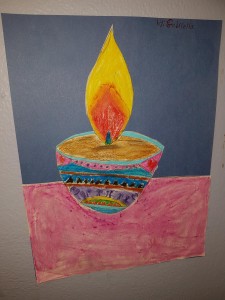 The Meaning of Diwali
The Festival of Lights, as with most ancient legends, helps us to know the truth of victory of good over evil, but more specifically for Hindus at this time, it means to understand the meanings behind each of the five days of Diwali. It specifically commemorates the return of Lord Rama to his kingdom Ayodhya, at the end of his exile which lasted for 14 years.
The Meaning of Diwali
The Festival of Lights, as with most ancient legends, helps us to know the truth of victory of good over evil, but more specifically for Hindus at this time, it means to understand the meanings behind each of the five days of Diwali. It specifically commemorates the return of Lord Rama to his kingdom Ayodhya, at the end of his exile which lasted for 14 years.
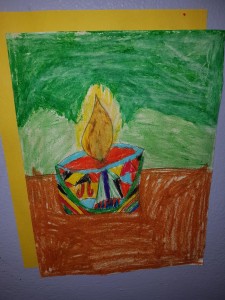 As with many eastern festivals, the dates are based on the Lunar calendar, with Diwali eve on the fourteenth lunar day of the month of Kartik (October/November).
As with many eastern festivals, the dates are based on the Lunar calendar, with Diwali eve on the fourteenth lunar day of the month of Kartik (October/November).
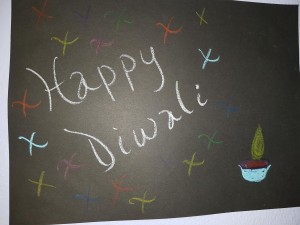 The special Festival of Light's, diyas, are lit to help the goddess (Mother) Lakshmi find her way into people's homes. Goddess Lakshmi is the symbol of wealth and prosperity.
The special Festival of Light's, diyas, are lit to help the goddess (Mother) Lakshmi find her way into people's homes. Goddess Lakshmi is the symbol of wealth and prosperity.
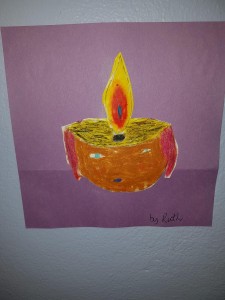 Grade 4 had a great time learning about Diwali! They used various art materials such as construction paper and oil pastels to create their own diyas!
Grade 4 had a great time learning about Diwali! They used various art materials such as construction paper and oil pastels to create their own diyas!
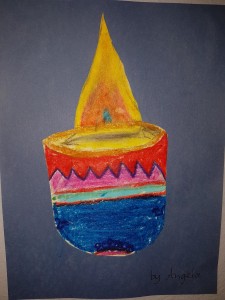 Beautiful work, Grade 4!
Beautiful work, Grade 4!
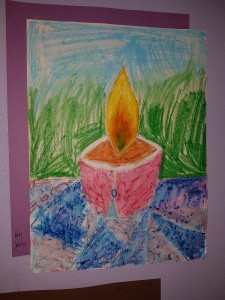
 Diwali (in Hindi) is the Hindu Festival of Lights. The name originally comes from the Sanskrit word dipavali, meaning a row of lights. Wherever Diwali is being celebrated you will see shops, houses and public places decorated with small, earthenware, oil lamps known as diyas. They are usually placed in rows on window sills and outside buildings as decorations.
Diwali (in Hindi) is the Hindu Festival of Lights. The name originally comes from the Sanskrit word dipavali, meaning a row of lights. Wherever Diwali is being celebrated you will see shops, houses and public places decorated with small, earthenware, oil lamps known as diyas. They are usually placed in rows on window sills and outside buildings as decorations.
 Diwali is celebrated around the world by people who follow the Hindu religion. This is mostly those of Indian ethnicity, but today they may be celebrating as British, American, Malaysian, Singaporean, Australian, Canadian, New Zealander, Fijian, Mauritian, South African, and many, many more countries around the world.
Diwali is celebrated around the world by people who follow the Hindu religion. This is mostly those of Indian ethnicity, but today they may be celebrating as British, American, Malaysian, Singaporean, Australian, Canadian, New Zealander, Fijian, Mauritian, South African, and many, many more countries around the world.
 The Meaning of Diwali
The Festival of Lights, as with most ancient legends, helps us to know the truth of victory of good over evil, but more specifically for Hindus at this time, it means to understand the meanings behind each of the five days of Diwali. It specifically commemorates the return of Lord Rama to his kingdom Ayodhya, at the end of his exile which lasted for 14 years.
The Meaning of Diwali
The Festival of Lights, as with most ancient legends, helps us to know the truth of victory of good over evil, but more specifically for Hindus at this time, it means to understand the meanings behind each of the five days of Diwali. It specifically commemorates the return of Lord Rama to his kingdom Ayodhya, at the end of his exile which lasted for 14 years.
 As with many eastern festivals, the dates are based on the Lunar calendar, with Diwali eve on the fourteenth lunar day of the month of Kartik (October/November).
As with many eastern festivals, the dates are based on the Lunar calendar, with Diwali eve on the fourteenth lunar day of the month of Kartik (October/November).
 The special Festival of Light's, diyas, are lit to help the goddess (Mother) Lakshmi find her way into people's homes. Goddess Lakshmi is the symbol of wealth and prosperity.
The special Festival of Light's, diyas, are lit to help the goddess (Mother) Lakshmi find her way into people's homes. Goddess Lakshmi is the symbol of wealth and prosperity.
 Grade 4 had a great time learning about Diwali! They used various art materials such as construction paper and oil pastels to create their own diyas!
Grade 4 had a great time learning about Diwali! They used various art materials such as construction paper and oil pastels to create their own diyas!
 Beautiful work, Grade 4!
Beautiful work, Grade 4!



